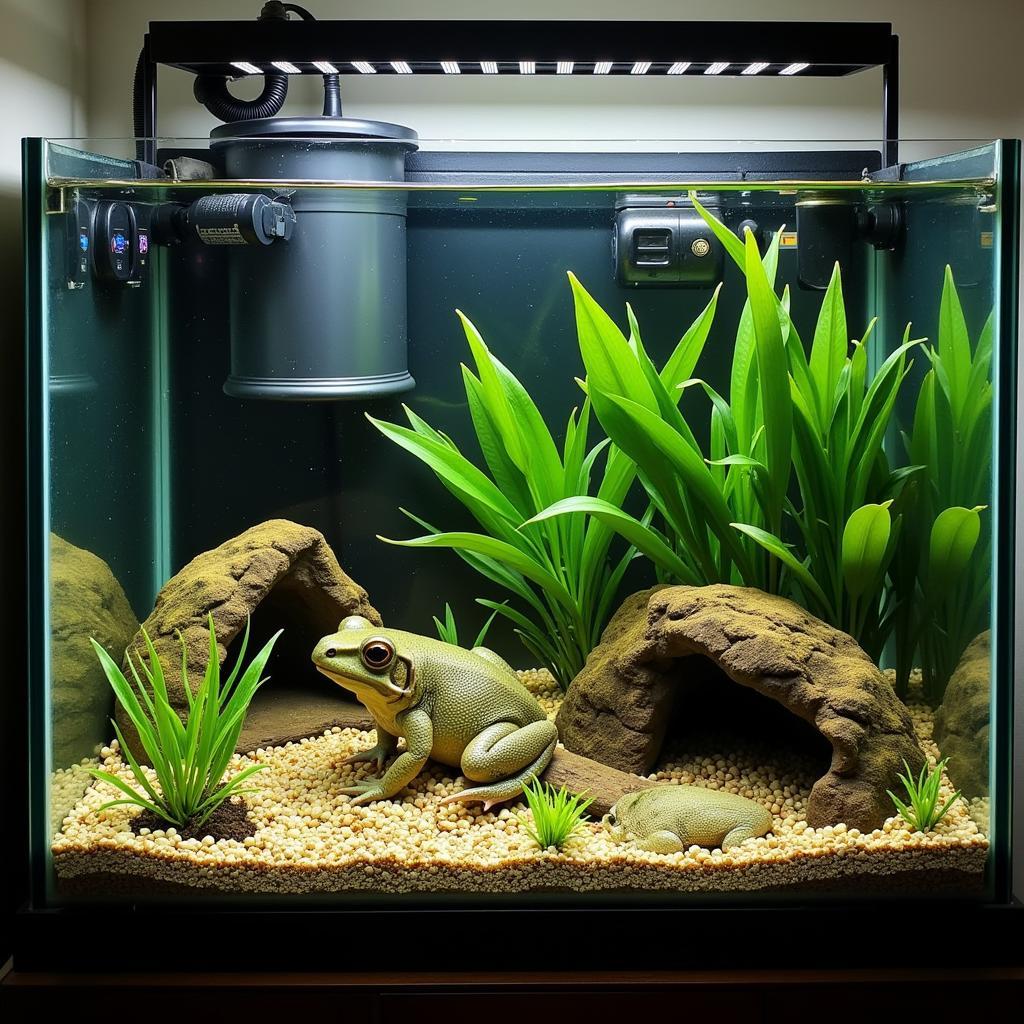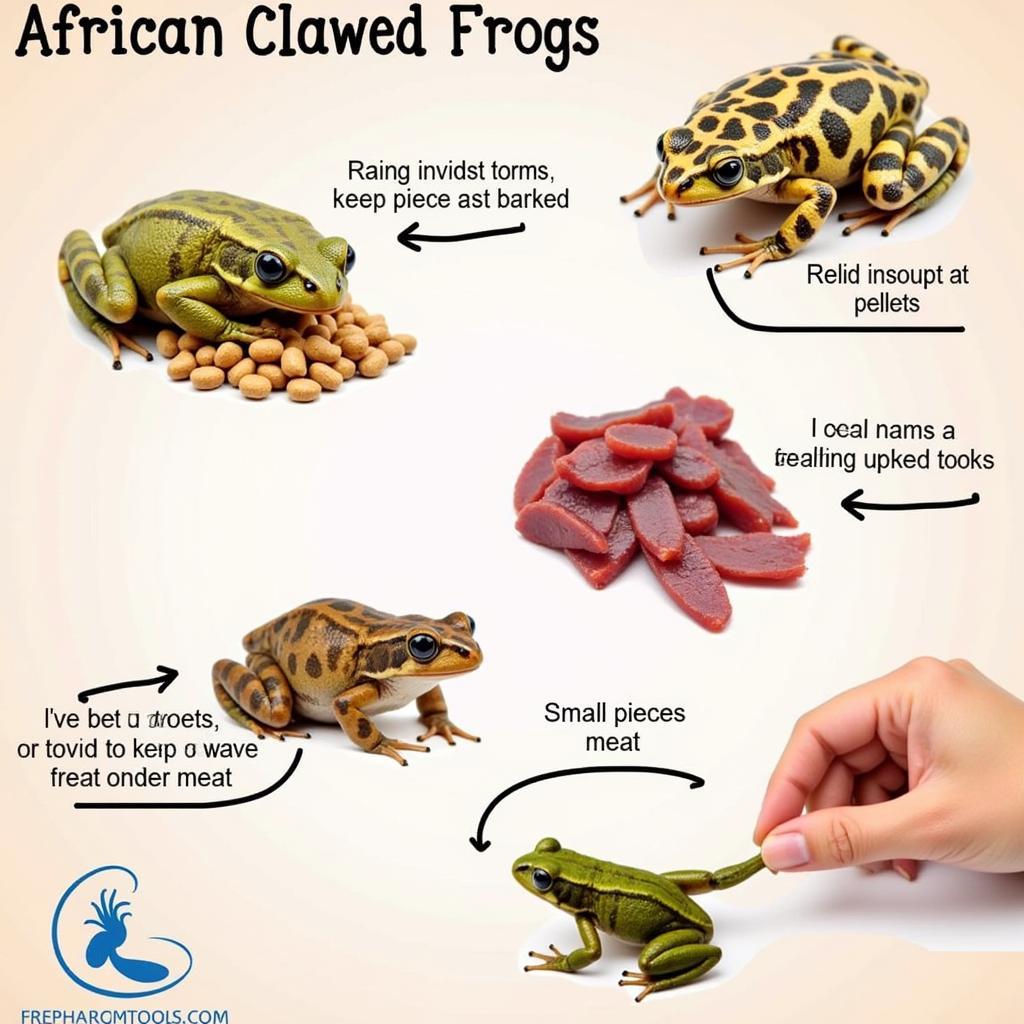African Clawed Frog Pet Care: A Comprehensive Guide
African Clawed Frog Pet Care requires a thorough understanding of their unique needs. These fascinating amphibians, native to Sub-Saharan Africa, make captivating pets with their curious personalities and relatively low-maintenance requirements. However, providing proper care is crucial for their health and well-being. This guide dives deep into the essential aspects of African clawed frog pet care.
Understanding the Basics of African Clawed Frog Care
Before welcoming an African clawed frog into your home, it’s essential to grasp the fundamentals of their care. These aquatic creatures thrive in specific water conditions and require a balanced diet to maintain optimal health.
Setting up the Ideal Habitat for Your African Clawed Frog
 African Clawed Frog Tank Setup Guide
African Clawed Frog Tank Setup Guide
A properly set up tank is crucial for the well-being of your African clawed frog. A 10-gallon tank is generally suitable for one or two frogs, but larger tanks are recommended for more. The tank should be filled with dechlorinated water and equipped with a reliable filter. Avoid using gravel or small stones as substrate, as these can be ingested by the frogs, leading to health complications. Smooth, larger rocks are a safer option. Provide hiding places such as caves, plants, or PVC pipes to help your frog feel secure.
What kind of tank do African clawed frogs need? African clawed frogs are fully aquatic and require a dedicated aquarium. An african clawed frog tank should mimic their natural environment as closely as possible.
Feeding Your African Clawed Frog
These frogs are carnivorous and have a healthy appetite. A varied diet consisting of commercially available frog pellets, bloodworms, brine shrimp, and occasionally earthworms or small pieces of lean meat will ensure they receive all the necessary nutrients. Avoid overfeeding, as this can lead to water quality issues. Feed them 2-3 times a week, ensuring they consume all food within a few minutes.
How often should I feed my African clawed frog? Overfeeding can be detrimental to their health and water quality. Stick to a regular feeding schedule of 2-3 times a week and monitor their weight to adjust portions as needed.
 African Clawed Frog Feeding Guide
African Clawed Frog Feeding Guide
Maintaining Water Quality for Your African Clawed Frog
Clean water is paramount for the health of your African clawed frog. Regular water changes are essential to remove waste and maintain optimal water parameters. Perform partial water changes of 25-50% every week or two, depending on the tank size and number of frogs. Use a gravel vacuum to remove debris from the substrate.
Importance of Dechlorination
Tap water contains chlorine and chloramine, which are harmful to amphibians. Always use a dechlorinator to neutralize these chemicals before adding water to the tank. What’s the african clawed frog scientific name? Knowing the scientific name, Xenopus laevis, can be helpful when researching specific care requirements.
Monitoring Water Parameters
Regularly test the water for ammonia, nitrite, and nitrate levels to ensure they are within acceptable ranges. High levels of these compounds can indicate poor water quality and can be harmful to your frog.
Common Health Concerns in African Clawed Frogs
While generally hardy, African clawed frogs can be susceptible to certain health issues. Recognizing the signs of illness and seeking veterinary care when necessary is important for responsible african clawed frog pet care.
Red Leg Syndrome
Red leg syndrome is a bacterial infection characterized by redness on the frog’s legs and underside. It can be life-threatening if left untreated.
Bloating
Bloating can occur due to various factors, including bacterial infections, parasites, or improper diet. A bloated frog may appear swollen and have difficulty swimming.
Dr. Evelyn Nkosi, a veterinarian specializing in exotic animals, advises, “Regular observation is key to early detection of health problems in African clawed frogs. Any changes in behavior, appetite, or physical appearance should be addressed promptly.”
Enrichment for Your African Clawed Frog
Providing enrichment activities for your African clawed frog can help stimulate their natural behaviors and improve their overall well-being.
Adding live plants to the tank not only enhances the aesthetics but also provides hiding places and foraging opportunities for the frog. Floating plants can create a sense of security, while rooted plants can offer a place to rest and explore.
Professor Adebayo Olajide, a renowned herpetologist, adds, “Enrichment is crucial for maintaining the psychological well-being of captive amphibians. Providing a stimulating environment can prevent boredom and stress, leading to a healthier and happier frog.” Thinking about the african conundrum helps us understand the complex issues surrounding conservation efforts for these and other African species.
Conclusion
Providing proper African clawed frog pet care involves creating a suitable environment, offering a balanced diet, maintaining water quality, and addressing potential health issues. By following these guidelines, you can ensure your African clawed frog thrives in your care, providing years of fascinating observation and companionship.
FAQ
- How long do African clawed frogs live? They can live for 15-20 years with proper care.
- Can I handle my African clawed frog? While possible, it’s best to avoid handling them as they have delicate skin and can absorb chemicals from your hands.
- What temperature should the water be? Maintain a temperature between 68-78°F (20-26°C).
- Are African clawed frogs social? They can be housed together, but ensure enough space to avoid territorial disputes.
- How can I tell if my frog is male or female? Males develop nuptial pads on their inner forearms during breeding season.
Do you have other questions related to African Dwarf Frog Swimming?
Check out this article: african dwarf frog swimming for more information.
Need Help?
For further assistance with your African Clawed Frog care, don’t hesitate to contact us.
Phone: +255768904061
Email: kaka.mag@gmail.com
Address: Mbarali DC Mawindi, Kangaga, Tanzania
We have a 24/7 customer service team available to assist you.